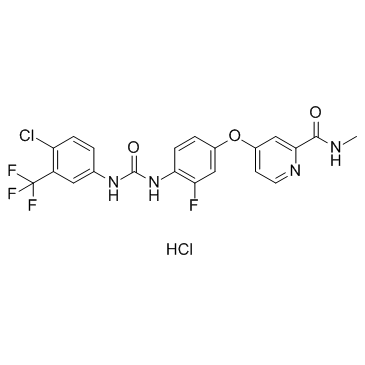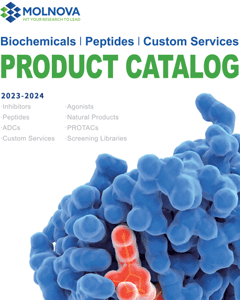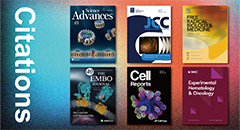
Regorafenib hydrochloride
CAS No. 835621-07-3
Regorafenib hydrochloride( BAY73-4506 hydrochloride )
Catalog No. M16096 CAS No. 835621-07-3
Regorafenib hydrochloride (BAY73-4506) is a potent, orally active multikinase inhibitor.
Purity : >98% (HPLC)
 COA
COA
 Datasheet
Datasheet
 HNMR
HNMR
 HPLC
HPLC
 MSDS
MSDS
 Handing Instructions
Handing Instructions
| Size | Price / USD | Stock | Quantity |
| 5MG | 27 | In Stock |


|
| 10MG | 42 | In Stock |


|
| 50MG | 87 | In Stock |


|
| 100MG | 132 | In Stock |


|
| 200MG | Get Quote | In Stock |


|
| 500MG | Get Quote | In Stock |


|
| 1G | Get Quote | In Stock |


|
Biological Information
-
Product NameRegorafenib hydrochloride
-
NoteResearch use only, not for human use.
-
Brief DescriptionRegorafenib hydrochloride (BAY73-4506) is a potent, orally active multikinase inhibitor.
-
DescriptionRegorafenib hydrochloride (BAY73-4506) is a potent, orally active multikinase inhibitor that potently inhibits endothelial cell kinases in biochemical and cellular kinase phosphorylation assays with nanomolar range (IC50=3-200 nM); inhibits VEGFR1/2/3, PDGFRβ, FGFR1, KIT, RET and B-RAF etc.; exhibits potent dose-dependent TGI in various preclinical human xenograft models in mice.Colon Cancer Approved(In Vitro):Regorafenib potently inhibits VEGFR2 autophosphorylation in NIH-3T3/VEGFR2 cells with an IC50 of 3 nM. In HAoSMCs, regorafenib inhibits PDGFR-β autophosphorylation after stimulation with PDGF-BB, with an IC50 of 90 nM. Regorafenib inhibits the proliferation of VEGF165-stimulated HUVECs, with an IC50 of 3 nM. Regorafenib causes a concentration-dependent decrease in Hep3B cell growth, having an IC50 of 5 μM. Regorafenib subsequently increases the levels of phospho-c-Jun, a JNK target, but not total c-Jun in Hep3B cells.(In Vivo):Regorafenib effectively inhibits growth of the Colo-205 xenografts in the dose range of 10-100 mg/kg reaching a TGI of 75% at day 14 at the 10 mg/kg dose. In the MDA-MB-231 model, regorafenib is highly efficacious at a dose as low as 3 mg/kg, resulting in a significant TGI of 81%, which increases to 93% at doses of 10 and 30 mg/kg, where tumor stasis is reached.
-
In VitroRegorafenib potently inhibits VEGFR2 autophosphorylation in NIH-3T3/VEGFR2 cells with an IC50 of 3 nM. In HAoSMCs, regorafenib inhibits PDGFR-β autophosphorylation after stimulation with PDGF-BB, with an IC50 of 90 nM. Regorafenib inhibits the proliferation of VEGF165-stimulated HUVECs, with an IC50 of 3 nM. Regorafenib causes a concentration-dependent decrease in Hep3B cell growth, having an IC50 of 5 μM. Regorafenib subsequently increases the levels of phospho-c-Jun, a JNK target, but not total c-Jun in Hep3B cells.
-
In VivoRegorafenib effectively inhibits growth of the Colo-205 xenografts in the dose range of 10-100 mg/kg reaching a TGI of 75% at day 14 at the 10 mg/kg dose. In the MDA-MB-231 model, regorafenib is highly efficacious at a dose as low as 3 mg/kg, resulting in a significant TGI of 81%, which increases to 93% at doses of 10 and 30 mg/kg, where tumor stasis is reached.
-
SynonymsBAY73-4506 hydrochloride
-
PathwayAngiogenesis
-
TargetVEGFR
-
RecptorVEGFR
-
Research AreaCancer
-
IndicationColon Cancer
Chemical Information
-
CAS Number835621-07-3
-
Formula Weight519.28
-
Molecular FormulaC21H16Cl2F4N4O3
-
Purity>98% (HPLC)
-
SolubilityDMSO: ≥ 5.6 mg/mL
-
SMILESCNC(=O)C1=NC=CC(=C1)OC2=CC(=C(C=C2)NC(=O)NC3=CC(=C(C=C3)Cl)C(F)(F)F)F.Cl
-
Chemical Name2-Pyridinecarboxamide, 4-[4-[[[[4-chloro-3-(trifluoromethyl)phenyl]amino]carbonyl]amino]-3-fluorophenoxy]-N-methyl-, hydrochloride (1:1)
Shipping & Storage Information
-
Storage(-20℃)
-
ShippingWith Ice Pack
-
Stability≥ 2 years
Reference
1. Wilhelm SM, et al. Int J Cancer. 2011 Jul 1;129(1):245-55.
2. Mross K, et al. Clin Cancer Res. 2012 May 1;18(9):2658-67.
3. Abou-Elkacem L, et al. Mol Cancer Ther. 2013 Jul;12(7):1322-31.
molnova catalog



related products
-
Motesanib
A potent, orally bioavailable, multikinase inhibitor inhibitor of VEGFR1/2/3, PDGFR and c-Kit with IC50 of 2-6 nM, 84 nM and 8 nM, respectively.
-
Regorafenib
A potent multikinase inhibitor that potently inhibits these endothelial cell kinases in biochemical and cellular kinase phosphorylation assays with nanomolar range (IC50=3-200 nM).
-
8-O-Acetylshanzhisid...
8-O-Acetylshanzhiside methylester has potential against cerebral ischemic injury, and its protective effect on oxygen-glucose deprivation-induced injury might be due to the suppression of intracellular Ca2+ elevation and caspase-3 activity.



 Cart
Cart
 sales@molnova.com
sales@molnova.com


